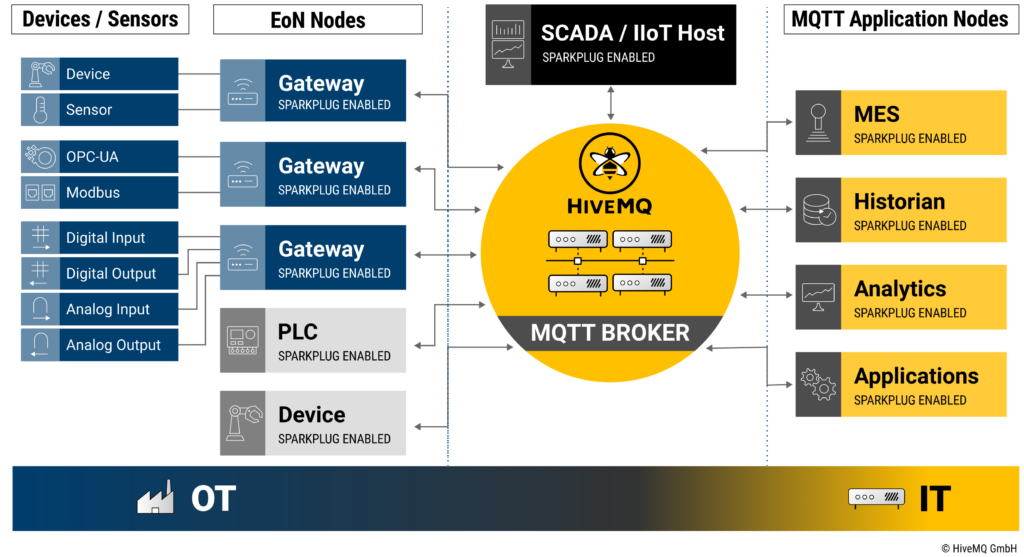MQTT has quickly become a standard in industrial environments, and MQTT Sparkplug is its data definition specification. MQTT Sparkplug allows for building mission-critical IIoT networks where operational data from edge devices and sensors is published back to applications like SCADA systems or historians for further processing.
What is MQTT Sparkplug?
MQTT Sparkplug specification offers a standard, open-source protocol for connecting industrial automation devices together. This protocol helps separate data between hardware and software systems and makes new devices easily discoverable within existing systems, creating one source of truth by eliminating siloes and data redundancy – making this ideal for use in smart manufacturing, industrial automation and real-time SCADA/control HMI applications.
MQTT Sparkplug B is an extension to MQTT protocol that adds support for real-time operational data in OT/SCADA applications. This module defines a topic namespace and payload definitions suitable for real-time operational data, speeding digital transformation of existing operations while speeding digitalization efforts.
While IT data requires structured information, modeling, and standardization, OT data tends to be unstructured, proprietary data that varies based on market segmentation. The two can often conflict: OT needs lightweight architecture with flexible data transmission that can be utilized by all machines and devices while IT demands structured, reliable information untethered from enterprise IT and easily integrated.
MQTT is a lightweight protocol for transporting data in both directions between MQTT Clients (end points), which create data, and an MQTT Server or broker which distributes it to other MQTT Clients (or subscribers), or clients. Using its publish/subscribe model, this enables one device to connect with multiple servers without being dependent on specific other devices’ presence.
MQTT communicates data via Topics, which is a standardized message structure with three parts. A topic is defined as any string within slashes; its payload contains data; while quality of service determines if its message should be delivered multiple times or only once.
MQTT Sparkplug Version 1.0 adds state information into payload messages through standardization of topic namespaces and payload formats, making state management simpler for message builders. Furthermore, LWT notifications inform subscribers when publishing clients are offline.
MQTT Sparkplug Architecture
MQTT Sparkplug is an extension of MQTT tailored specifically for industrial automation and the IIoT. It includes features like process variable payloads with OS-centric payload management as well as state management that meet mission-critical operations’ demands. Furthermore, its scalable nature enables increasing networks.
Sparkplug MQTT follows the traditional pub/sub messaging model used by vanilla MQTT; data producers publish topics, while subscribers subscribe. However, the central MQTT broker performs additional important tasks, including authentication, authorization, and state management – making it a potential single point of failure and so it is advised to add redundancy by using multiple brokers simultaneously in your architecture.
Another key feature is its unified namespace, which serves as a standardized way of representing data and metadata in MQTT messages, improving interoperability and simplifying integration among devices and applications.
A unified namespace is essential in reducing confusion between industrial devices and systems. Imagine two manufacturing plants who utilize different naming conventions for their PLCs (programmable logic controllers), leading to significant difficulties when trying to communicate between their systems. MQTT Sparkplug helps eliminate this difficulty by offering a standard format for structuring messages within MQTT protocol allowing companies to easily integrate together.
MQTT Sparkplug defines how to manage state and session information. For instance, when devices disconnect from the network they will send a “death” message directly to their MQTT broker who in turn sends this message onward to subscribers for them to resynchronize their states – an essential feature for real-time SCADA/control HMI systems.
MQTT Sparkplug also allows manufacturers to integrate legacy devices without replacing them, an essential step in transitioning to Industry 4.0 and helping ensure all data can be trusted. IoT Worlds used MQTT Sparkplug recently to build a data model on the edge which captured attributes and process variables as one source of truth. Contact us today to support you for your project.
MQTT Sparkplug Broker
When a device publishes data, the MQTT Sparkplug broker ensures all subscribed applications receive it simultaneously using the Last Will and Testament (LWT) feature of MQTT – this enables publishing clients to communicate their status to subscribing applications and deliver any LWT payloads when publishing clients go offline/back online. In essence, when publishing clients go offline/online the broker sends LWT payloads whenever publishing clients become inactive/online again.
MQTT Sparkplug architecture provides several benefits when applied to IIoT and automation systems. First off, it reduces the number of connections between devices, servers, and client tools by switching everything pub-sub instead of client-server, making scaling simpler without load balancing solutions.
MQTT Sparkplug protocol’s session state awareness feature is essential to mission-critical applications such as real-time SCADA systems. When connections are interrupted or lost, this feature ensures that when reconnections take place they resume at precisely where they left off reducing both downtime and data loss – particularly helpful in industrial environments requiring high availability levels.

MQTT Sparkplug also defines a predefined topic structure and payload for industrial data, making sharing easy between IT and OT teams. By setting a standard naming convention for devices and systems connecting through Unified Namespaces.
MQTT Sparkplug is an effective way to enhance the scalability and reliability of your IIoT infrastructure. If you want to learn more about how MQTT Sparkplug could assist with digital transformation efforts at your organization, don’t hesitate to get in touch! We would be more than happy to show you how MQTT can fit seamlessly into your environment, helping your journey start today.
MQTT Sparkplug Topics
MQTT Sparkplug provides an effective method of sharing industrial device data across devices and systems using a standard topic structure, making contextualized information available across OT and IT applications for accurate analysis and predictive control. Furthermore, its standardization reduces custom code writing requirements, ensures data publication in meaningful manner and prevents miscommunication between systems due to different naming conventions for similar devices.
MQTT, used by Sparkplug, is an open source messaging protocol which makes it possible to publish and subscribe to data from remote machines. As an extremely flexible protocol that can be utilized in a variety of applications, MQTT has gained popularity within operational technology due to its easy integration into other systems while remaining secure and scalable – often used by operational technology for providing real-time data to business systems.
While MQTT’s versatility can be immensely advantageous in an industrial setting, its management can be complex. Each device may use a unique name for their communication registers and require detailed documentation to inform users what those registrations mean. Without adequate documentation this lack of consistency may create tight couplings within control system architecture, delay new device integration and leave too much open to interpretation or miscommunication.
To address these challenges, the Eclipse Foundation formed the MQTT Sparkplug Working Group – an open community comprised of end users, integrators and vendors collaborating together on making MQTT easier to use in industrial settings.
The MQTT Sparkplug specification defines a standard MQTT Namespace and Payload definition optimized for industrial application use cases, as well as state management and high-availability MQTT architectures to support redundancy and scale. As industry needs evolve and change, the specification will also continue to adapt accordingly.
By integrating with these brokers, IoT Worlds can collect and pack various data collected from industrial devices before publishing it to standard MQTT topics, providing you with all relevant data for operational or business applications.
IoT Worlds can support your Company in any IIoT project phase, contact us.


